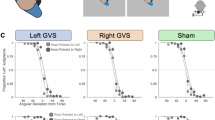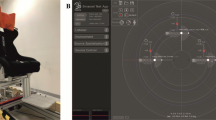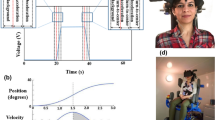Abstract
We studied the contribution of vestibular and somatosensory/proprioceptive stimulation to the perception of the apparent zenith (AZ). Experiment 1 involved rotation on a centrifuge and settings of the AZ. Subjects were supine on the centrifuge, and their body position was varied in relation to the rotation axis so that the gravitoinertial resultant force at the otoliths was 1 or 1.2 g with the otolith organs positioned 50 or 100 cm from the axis of rotation. Their legs were also positioned in different configurations, flexed and elevated or extended, to create different distributions of blood and lymph. Experiment 2 involved (a) settings of the AZ for subjects positioned supine with legs fully extended or legs flexed and elevated to create a torsoward shift of blood and (b) settings of the subjective visual vertical for subjects horizontally positioned on their sides with legs extended or bent. Experiment 3 had subjects in the same body configurations as in Experiment 2 indicate when they were horizontal as they were rotated in pitch or roll about an inter-aural or naso-occipital axis. The experimental results for all three experiments demonstrated that both visual localization and apparent body horizontal are jointly determined by multimodal combinations of otolithic and somatosensory/proprioceptive stimulation. No evidence was found for non-overlapping or exclusive mechanisms determining one or the other. The subjective postural horizontal and AZ were affected in similar ways by comparable manipulations.






Similar content being viewed by others
References
Benson AJ (1990) Sensory functions and limitations of the vestibular system. In: Warren R, Wertheim AH (eds) Perception and control of self-motion. Erlbaum, Hillsdale, pp 145–170
Bortolami SB, Rocca S, Daros S, DiZio P, Lackner JR (2006) Mechanisms of human static spatial orientation. Exp Brain Res 173:374–388
Bourdon B (1906) Concerning the role of the head in the perception of space. Rev Phil 61:526–529
Carriot J, Charles C, Huffenus AF, Nougier V, Raphel C, Cian C (2005) Effect of low gravitational stimulation on the perception of target elevation: role of spatial expertise. Percept Psychophys 67:1044–1051
Carriot J, Barraud PA, Nougier V, Cian C (2006) Difference in the perception of the horizon during true and simulated tilt in the absence of semicircular canal cues. Exp Brain Res 174:158–166
Carriot J, DiZio P, Nougier V (2008) Vertical frames of reference and control of body orientation. Neurophysiol Clin 38:423–437
Clark B, Graybiel A (1949) Apparent rotation of a fixed target associated with linear acceleration in flight. Am J Ophthalmol 32:549–557
Clark B, Graybiel A (1966) Perception of the visual horizontal in normal and labyrinthine defective observers during prolonged rotation. Am J Psychol 79:608–612
Cohen MM, Stopper A, Welch R, DeRochia C (2001) Effects of gravitational and optical stimulation on the perception of target elevation. Percept Psychophys 63:29–35
DeBeer GR (1947) The differentiation of neural crest cells into visceral cartilages and odontoblasts in Amblystoma, and a re-examination of the germ layer theory. Proc R Soc B Biol Sci 134:377–398
DiZio P, Li W, Lackner JR, Matin L (1997) Combined influences of gravitoinertial force level and visual field pitch on visually perceived eye level. J Vestib Res 7:381–392
Fernandez C, Goldberg JM (1976) Physiology of peripheral neurons innervating otolith organs of the squirrel monkey. III. Response dynamics. J Neurophysiol 39:996–1008
Graybiel A (1952) Oculogravic illusion. AMA Arch Ophthalmol 48:605–615
Graybiel A, Clark B (1965) Validity of the oculogravic illusion as a specific indicator of otolith function. Aerosp Med 36:1173–1181
Graybiel A, Patterson JL Jr (1955) Thresholds of stimulation of the otolith organs as indicated by the oculogravic illusion. J Appl Physiol 7:666–670
Graybiel A, Miller EF, Newson BD, Kennedy RS (1968) The effect of water immersion on perception of the oculogravic illusion in normal and labyrinthine-defective subjects. Acta Otolaryngol 65:599–610
Jarchow T, Mast FW (1999) The effect of water immersion on postural and visual orientation. Aviat Space Environ Med 70:879–886
Kaptein RG, Van Gisbergen JA (2004) Interpretation of the discontinuity in the sense of verticality at large body tilt. J Neurophysiol 91:2205–2214
Mittelstaedt H (1983) A new solution to the problem of the subjective vertical. Naturwissenschaften 70:272–281
Mittelstaedt H (1988) The information of processing structure of the subjective vertical. A cybernetic bridge between its psychophysics and its neurobiology. In: Processing structures for perception and action. Verlagsgesellschaft, Weinheim, pp 216–263
Mittelstaedt H (1989) The role of the pitched-up orientation of the otoliths in two recent models of the subjective vertical. Biol Cybern 61:405–416
Mittelstaedt H (1996) Somatic graviception. Biol Psychol 42:53–74
Mittelstaedt H, Fricke E (1988) The relative effect of saccular and somatosensory information on spatial orientation and control. Adv Otorhinolaryngol 42:24–30
Patterson JL, Graybiel A (1974) Acceleration gravity, and weightlessness. In: Slonim NB (ed) Environmental physiology. St. Louis Mosby Company, pp 163–275
Pozzo T, Berthoz A, Lefort L (1990) Head stabilization during various locomotor tasks in human. I. Normal subjects. Exp Brain Res 82:97–106
Trousselard M, Cian C, Nougier V, Pla S, Raphel C (2003) Contribution of somaesthetic cues to the perception of body orientation and subjective visual vertical. Percept Psychophys 65(8):1179–1187
Vaitl D, Mittelstaedt H, Baisch F (1997) Shifts in blood volume alter the perception of posture. Int J Psychophysiol 2:99–105
Vaitl D, Mittelstaedt H, Saborowski R, Stark R, Baisch F (2002) Shifts in blood volume alter the perception of posture: further evidence for somatic graviception. Int J Psychophysiol 44:1–11
Van Beuzekom AD, Van Gisbergen JA (2000) Properties of the internal representation of gravity inferred from spatial direction and body tilt estimates. J Neurophysiol 84:11–27
Acknowledgments
The authors would like to thank Professor MITTELSTAEDT for his helpful and graceful comments and valuable suggestions. Professor MITTELSTAEDT still disagrees with some of our conclusions and future experiments will be necessary to resolve the discrepancy between his and our interpretations. Gratitude is also expressed to PA BARRAUD and A ROUX of the Instrumentation and Technological Research Service of the Centre de Recherches du Service de Santé des Armées for the construction of the experimental device and the technical expertise and assistance. Amy LAVALLEE conducted Experiment 3 and did an outstanding job. The authors would like also to thank Dr KH KIM and W KUCHARSKI for developing software and hardware, respectively, for Experiment 2. Professor JR Lackner was supported by U.S. Air Force Office of Scientific Research grant FA9550 06 1 0102.
Author information
Authors and Affiliations
Corresponding author
Rights and permissions
About this article
Cite this article
Carriot, J., Cian, C., Paillard, A. et al. Influence of multisensory graviceptive information on the apparent zenith. Exp Brain Res 208, 569–579 (2011). https://doi.org/10.1007/s00221-010-2505-y
Received:
Accepted:
Published:
Issue Date:
DOI: https://doi.org/10.1007/s00221-010-2505-y




